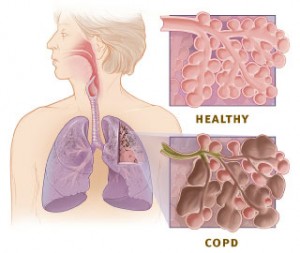Screen legend Tony Curtis dead at 85

Screen legend Tony Curtis has died. The 85 year old actor, father of actress Jamie Lee Curtis, is known for his roles in Houdini, Spartacus, and his most beloved role as Joe in Some Like It Hot with Marilyn Monroe and Jack Lemmon. Curtis died of a heart attack at his home in Las Vegas. Curtis also suffered from chronic obstructive lung disease and was admitted to a Las Vegas hospital over the summer with an asthma attack.
COPD, or chronic obstructive pulmonary disease, is a progressive disease that makes it hard to breathe. “Progressive” means the disease gets worse over time. COPD is a major cause of disability, and it’s the fourth leading cause of death in the United States. More than 12 million people are currently diagnosed with COPD. An additional 12 million likely have the disease and don’t even know it.
COPD can cause coughing that produces large amounts of mucus, wheezing, shortness of breath, chest tightness, and other symptoms.
Cigarette smoking is the leading cause of COPD. Most people who have COPD smoke or used to smoke. Long-term exposure to other lung irritants, such as air pollution, chemical fumes, or dust, also may contribute to COPD.
To understand COPD, it helps to understand how the lungs work. The air that you breathe goes down your windpipe into tubes in your lungs called bronchial tubes, or airways.
The airways are shaped like an upside-down tree with many branches. At the end of the branches are tiny air sacs called alveoli).
The airways and air sacs are elastic. When you breathe in, each air sac fills up with air like a small balloon. When you breathe out, the air sac deflates and the air goes out.
 In COPD, less air flows in and out of the airways because of one or more of the following:
In COPD, less air flows in and out of the airways because of one or more of the following:
* The airways and air sacs lose their elastic quality.
* The walls between many of the air sacs are destroyed.
* The walls of the airways become thick and inflamed (swollen).
* The airways make more mucus than usual, which tends to clog the airways.
In the United States, the term “COPD” includes two main conditions—emphysema and chronic obstructive bronchitis.
In emphysema, the walls between many of the air sacs are damaged, causing them to lose their shape and become floppy. This damage also can destroy the walls of the air sacs, leading to fewer and larger air sacs instead of many tiny ones.
In chronic obstructive bronchitis, the lining of the airways is constantly irritated and inflamed. This causes the lining to thicken. Lots of thick mucus forms in the airways, making it hard to breathe.
Most people also have COPD have both emphysema and chronic obstructive bronchitis. Thus, the general term “COPD” is more accurate.
How Is COPD Treated?
Currently there is no cure for COPD. However, treatments and lifestyle changes can help patients feel better, stay more active, and slow the progress of the disease.
Quitting smoking is the most important step one can take to treat COPD. See our article about actress Jean Simmons to learn more about smoking cessation programs. The National Heart, Lung, and Blood Institute’s “Your Guide to a Healthy Heart” booklet has more information about how to quit smoking.
Other treatments for COPD may include medicines, vaccines, pulmonary rehabilitation, oxygen therapy, surgery, and managing complications.
The goals of COPD treatment are to:
- Relieve symptoms
- Slow the progress of the disease
- Improve exercise tolerance (your ability to stay active)
- Prevent and treat complications
- Improve overall health
Medications:
Bronchodilators relax the muscles around in the airways opening the airways and making breathing easier. Depending on how severe the disease, a physician may prescribe short-acting or long-acting bronchodilators. Short-acting bronchodilators last about 4 to 6 hours and should be used only when needed. Long-acting bronchodilators last about 12 hours or more and are used every day. Most bronchodilators are taken using a device called an inhaler. This device allows the medicine to go directly to the lungs.
Inhaled steroids are used for some people who have moderate or severe COPD. These may reduce airway inflammation (swelling).
Vaccines:
The flu (influenza) can cause serious problems for people who have COPD. Flu shots can reduce the risk. It should be given each year as the vaccine changes each year to match the strains of virus that will likely cause the flu during that particular flu season. NOTE: This year’s flu vaccine is available and should be given to all high risk individuals.
Pneumococcal Vaccine lowers the risk for pneumococcal pneumonia and its complications. People who have COPD are at higher risk for pneumonia than people who don’t have COPD.
Pulmonary Rehabilitation
Pulmonary rehab is a medically supervised program that helps improve the health and well-being of people who have lung problems. Rehab may include an exercise program, disease management training, and nutritional and psychological counseling. The program aims to help patients stay active and to be able to carry out day-to-day activities.
Oxygen Therapy
With severe COPD oxygen levels in the blood can become low. Oxygen therapy can help these patiets breathe better. Oxygen is given from a tank through nasal prongs or a mask. Some people will only need oxygen for part of the day, others may need to be on it all day.Using extra oxygen for most of the day can help those with severe COPD:
* Do tasks or activities, while having fewer symptoms
* Protect their hearts and other organs from damage
* Sleep more during the night and improve alertness during the day
* Live longer
Source: NHLBI
For more information about COPD, click here to go to the Resounding Health Casebook on COPD.
























0 comments